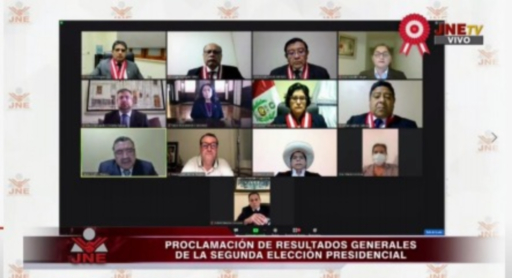| [With EMBs] Interview with National Electoral Tribunal of Peru | ||||||||||||
|---|---|---|---|---|---|---|---|---|---|---|---|---|
| Last updated 2021-09-30 | ||||||||||||
|
New Changes Implemented During 2021 General Elections (National Electoral Tribunal of Peru)
For the 2021 general elections of Peru, the National Electoral Tribunal of Peru (Jurado Nacional de Elecciones, JNE) made a few changes developed by the Fact-Checking Technical Committee (Comite Tecnico de Fact-Checking, CTFC) using new technologies. Here the Secretariat shares an interview with JNE discussing its election management in the midst of the COVID-19 pandemic and its determination that it will continue to strengthen democracy and governance in Peru, thus contributing to building a prosperous and sustainable country. ▶Question: Which election(s) were held in 2021 in Peru? ▶Answer: Peru´s 2021 general elections were held on April 11. The first round of the presidential election was held on April 11 and the second round on June 6. The JNE of Peru announced the final results of the election of 130 Congressmen, 5 Representatives to the Andean Parliament, and the President and Vice President on June 9, June 16, and July 19 respectively. In the 2021 elections, 25,287,954 were eligible to vote, and the country recorded voter turnout rates of 70% in the first round and 75% in the second one. Besides COVID-19, despite difficulties and challenges such as the spread of misinformation and mistrust in the electoral process, the 2021 general elections were successfully held coinciding with the bicentennial of Peru´s Independence. ▶Question: How did COVID-19 change the election process and election management? ▶Answer: Elections during the pandemic brought many positive changes. Seven main changes are following. 1. Parties and candidates for the 2021 general elections registered on the Digital Electoral Portal. Updated regularly, the Portal showed the following information: new political organization registrations, exclusions and renunciations of membership registration, party affiliation, statutes amendments. 2. Electoral participation is compulsory for all citizens between 18 and 70 in Peru. For the 2021 elections, the voting exemption procedure was publicized as well. The procedure is set in accordance with the Rule of Voting Exoneration and complementary rules, applicable to the following cases: - Individuals older than 65 years - Individuals diagnosed with diseases including COVID-19 - Individuals who experienced a death of a close family member in a period of 5 days before the day of the election - Individuals traveling abroad for academic or medical reasons - Natural disasters or force majeure - Individuals with physical or mental illness or sensory or intellectual disabilities - Individuals in lactation - Individuals whose ID was stolen or lost in a period of 10 days before the day of the election - Cases where issue(s) occur during the election day caused by the electoral organizations, wrong information in the electoral register, or any election incident 3. The electoral justice administration was digitalized. It presented the jurisdictional documents related to the 2021 electoral process through a platform called the “Integrated Jurisdictional Electronic Dossier System” (SIJE-E). For the first time, electoral hearings were held virtually, and broadcasted on television. Alongside the debates, the resolution of appeals requests was also broadcasted. Despite the difficulties caused by the COVID-19 pandemic, the system made it possible to promptly manage the requests submitted and the enormous quantity of annulled election results. 4. In compliance with safety measures, five face-to-face electoral debates were broadcasted. Measures were taken to protect the health of people present in the debates while ensuring the right of voters to be well-informed. 5. More than 16,000 polling officers went through online training and received Personal Protective Equipment (PPE) and sanitary kits for the election day. 6. CTFC was formed to deal with the unprecedented volume of misinformation and fake news on social media. The Committee posted its work and results on social media channels including Twitter, and Facebook during the elections: more than 11 million citizens read the posts. It monitored a total of 70 postings containing misinformation and/or disinformation regarding the election and the electoral process.
7. Precautionary plans and safety measures were implemented to protect voters, poll workers, and election stakeholders. ▶Question: Do you have any upcoming election(s), plan of actions or changes to future election management practices that you wish to share with A-WEB and Member EMBs? ▶Answer: October 10 is the scheduled date for a popular consultation in 13 districts to revoke the mandate of popularly elected municipal authorities. Voters will decide to dismiss them from their positions. Also, complementary municipal elections in the District of Chipao were postponed after the COVID-19 outbreak. The elections had been scheduled to be held in March 2020; however, it was postponed due to the emergency declaration to stop the spread of COVID-19. Coordination will be carried out in due course between the bodies of the electoral system and the Executive Branch to determine a new date for the electoral process.  The A-WEB Secretariat appreciates the National Electoral Tribunal of Peru for sharing their special measures they adopted to manage elections under the pandemic conditions. The Secretariat will continue to conduct these interviews so that A-WEB members may share their hands-on experience they have gone through to conduct elections in challenging circumstances. |
